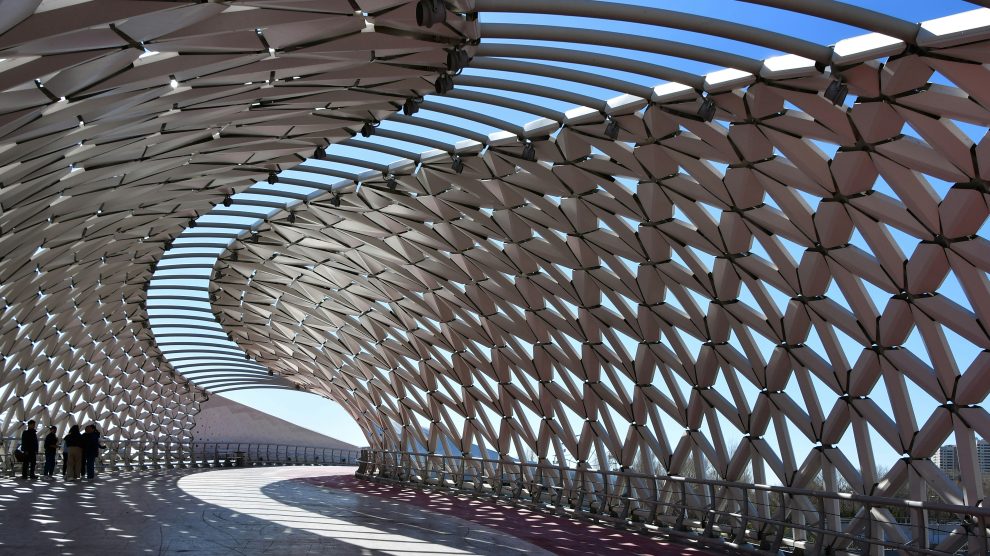Central Asia’s cities remain unique, shaped by histories that link Turkic, Persian, Russian, and Soviet legacies. The question is whether their evolution can be guided in a way that balances the appeal of shining skyscrapers with the equally pressing needs of housing, healthcare, and community well-being.
As the midday sun reflects off the sleek, tall towers of the Kazakh capital Astana, the city can appear to have sprung from the wide Kazakh steppe as if conjured by an architect’s wild imagination.
Shimmering glass facades play host to images of the surrounding desert plains, reflecting both an ancient landscape and a modern impulse toward grandeur.
On ground level, broad boulevards frame manicured lawns and futuristic sculptures, while the air buzzes with the hum of yet more construction. Cranes punctuate nearly every vista, testifying to the city’s relentless ambition to reshape its skyline and declare itself a regional hub for innovation and progress. Astana’s story, however, is but one chapter of the remarkable urban transformation that is underway across Central Asia.
These cities of the steppe—once largely defined by Soviet-era uniform blocks and utilitarian planning—are catching the world’s eye with sleek new districts and infrastructural leaps.
Astana’s metamorphosis from a modest town to a capital of over a million inhabitants illustrates the region’s appetite for reinvention. No longer content to be outposts between Europe and Asia, these cities aspire to become self-sustaining powerhouses in their own right.
The thirst for grand architectural statements is part of a wider plan to position Central Asia on the world map for trade, culture, and investment. But behind the gleaming facades lies a more complicated narrative of social disparities, climate challenges, and the delicate dance between preserving heritage and heralding innovation.
The projection of modernity
Astana’s rapid architectural development is a testament to Kazakhstan’s broader national strategy. The city has devoted ample resources to iconic structures such as the Bayterek Tower, a soaring monument whose silhouette has become as emblematic as other global landmarks.
Government ministries and corporate headquarters are housed in contemporary complexes designed by international firms eager to showcase their prowess on this new frontier of possibility. The public response has been a blend of pride, excitement, and apprehension.
While locals applaud the job opportunities generated by major construction projects, many worry that the city’s galloping growth may leave some residents behind. Rising property prices, an increasingly congested transport network, and doubts about long-term sustainability lurk behind the glossy promise of these futuristic urban trappings.

Astana’s Bayterek Tower.
Further south, Tashkent has embarked on a broad-based regeneration programme that promises to reverse years of stagnation in Uzbekistan’s largest city.
Since the country began opening up economically and politically in recent years, Tashkent’s planning authorities have been given ample scope to think creatively about reviving historic neighbourhoods while encouraging new development.
Nondescript Soviet-era buildings along central thoroughfares have been repurposed or replaced by upscale retail outlets, restaurants, and cultural centres. Tree-lined avenues that once suffered from neglect are now receiving a facelift, with expanded pedestrian zones and improved public transport.
Like Astana, Tashkent symbolises a broader attempt by its government to project modernity. The hope is to tempt investors, multinational firms, and a tourist base that has typically overlooked the region’s wealth of Islamic architecture and Silk Road history.
Brand Central Asia
Almaty presents another angle of Central Asia’s urban transformation. Formerly Kazakhstan’s capital, it relinquished that status to Astana but remains the country’s financial and cultural heart. Tucked beneath the imposing peaks of the Tian Shan mountains, Almaty’s silhouette is less futuristic than Astana’s but brims with a creative energy all its own.
Elegant boulevards lined with cafes, galleries, and small tech start-ups have turned once-dreary spaces into vibrant cultural districts. A wave of young entrepreneurs, many educated abroad, has spurred the opening of co-working spaces, art collectives, and boutique hotels. The city has also invested heavily in transit systems and green spaces to accommodate a growing population.
Residents, meanwhile, have shown an eagerness to engage in community projects designed to preserve Almaty’s charm while ushering in a new era of cosmopolitan verve.
Such evolution inevitably hinges on technological innovations. Across the region, municipal authorities speak enthusiastically about plans to implement smart grids, install public Wi-Fi networks, and deploy sophisticated traffic management systems.
Astana leads the pack with experimental pilot programmes that marry artificial intelligence and data analytics to optimise energy consumption and monitor urban mobility. Tashkent and Almaty are hardly far behind.
Their governments have announced partnerships with global technology firms to provide the digital backbone required to support rapidly expanding populations. Yet sceptics question whether these moves will be more than mere exercises in branding.
Ensuring these high-tech aspirations translate into genuine improvements for everyday residents—reliable electricity, faster internet connections, safer roads—will demand political will, transparent governance, and consistent funding. No city can remain at the mercy of underinvestment in the intangible infrastructure on which every metropolis depends.
Social inequality
In embracing these improvements, Central Asia’s cities must also confront widening social inequalities. The wave of rural-to-urban migration continues unabated as families leave diminishing agricultural opportunities in the countryside to seek better livelihoods in the city.
Their arrival places mounting pressure on housing markets, social services, and job availability. In Astana, the glitzy new developments do little to solve the gap in affordable residences. Many new arrivals find themselves in unregulated settlements on the fringes of the city, lacking decent sanitation or steady access to utilities.
Tashkent has tried to address similar challenges through controlled housing projects, but private real-estate developers often cater to higher-end segments, leaving low-income families to fend for themselves. As policymakers race to attract global businesses, they must be careful not to neglect basic amenities like schools, clinics, and public transport for the city’s most vulnerable. Failing to do so risks breeding resentment and undermining the cohesion upon which a truly modern city depends.
Healthcare and education disparities also loom large. Even as new hospitals appear with cutting-edge equipment, they remain inaccessible to many rural migrants, either due to cost or location. Meanwhile, posh international schools are sprouting across urban centers, catering to an affluent class that can afford steep tuition fees.
Local public schools, by contrast, often struggle to keep pace with increasing enrollment and a shortage of qualified teachers. Addressing this imbalance is essential, given Central Asia’s goal of fostering a generation of skilled workers capable of supporting complex digital economies. Programmes to retrain teachers, upgrade classrooms, and offer subsidised health insurance may help close these gaps, but they require deep pockets and political resolve.
Climate resilience
Amid these social and technological shifts, city planners in the region have begun taking climate resilience more seriously. Astana, perched on a windy steppe with extreme winter temperatures, faces distinct challenges in heating and sustainability.
The city’s grid must manage energy demand spikes during sub-zero months, a problem that calls for improved insulation in buildings, modernised heating networks, and the deployment of renewable power where feasible.
Tashkent, by contrast, contends with scorching summers and occasional water and power shortages. One response involves the creation of green corridors—linear parks and tree belts that reduce urban heat and help manage stormwater.
Almaty, set against looming mountains, has to grapple with the possibility of flash floods and mudslides triggered by glacial melt. Efforts to build flood defences, improve drainage systems, and preserve natural watershed areas are no longer the preserve of environmental activists alone; they are high priorities for municipal governments eager to protect their rapidly expanding populations.
The pursuit of climate resilience aligns closely with the question of how to maintain livability amid breakneck development. Green spaces are no longer an afterthought but rather an integral part of city planning.
Almaty has embarked on projects to rehabilitate its rivers and open up recreational areas for locals, fostering an appreciation for the local environment that can help galvanise further initiatives. In Tashkent, authorities have experimented with community-driven waste management schemes, where citizens are encouraged to separate recyclables and keep public parks clean.
These measures, while modest, speak to an encouraging shift in mindset—a recognition that sustainable urban growth must involve not merely erecting modern structures but also ensuring that every city has a viable plan to handle the environmental consequences of expansion.
More than a crossroads
For all these shared challenges, Central Asia’s cities remain unique, shaped by histories that link Turkic, Persian, Russian, and Soviet legacies. The question is whether their evolution can be guided in a way that balances the appeal of shining skyscrapers with the equally pressing needs of housing, healthcare, and community well-being.
Astana, Tashkent, and Almaty demonstrate that Central Asia is more than just a crossroads for trading caravans and pipelines. If they can navigate social inequalities and the looming effects of climate change while seizing the opportunities of digital innovation, these urban centres stand poised to become dynamic hubs in their own right.
The process of transformation might not be smooth or evenly distributed, but these cities have shown a remarkable capacity for reinvention. Their next chapter will be written in the shimmering skylines, digitised transport systems, and green corridors that connect residents to the landscapes of their ancestors.
If done thoughtfully, the journey from post-Soviet sprawl to twenty-first-century metropolises could offer a model of resilience for much of the developing world—and indeed for all cities seeking to marry ambition with equity and sustainability.
Top photo by Tim Broadbent on Unsplash.
At Emerging Europe, we use an integrated approach centred around market intelligence to help organisations understand trends and strategically position themselves for success.
Learn how our solutions can help you thrive in the region:
Company and Services Overview | Strategic Advantage.


Add Comment